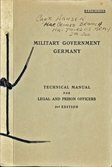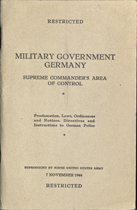The 20th Century
The Treaty of Versailles ending World War I came at a steep cost to Germany. It was controversial even at the time, though appeared to most of the allies as the just punishment of an unjust aggressor. The treaty stripped significant portions of territory, established a standing occupation force, greatly limited the German military, and demanded from Germany the payment of heavy reparations. It has been linked by scholars both to the rise of Fascism in Italy and Nazism.
Our copy of a German printing of the Treaty of Versailles, with introduction, appendix and index, comes from the personal library of Hermann Kantorowicz (1877-1940), one of the great legal scholars of the 20th century. A renowned figure in the philosophy of law, medieval legal history, and criminal law, Kantorowicz lost his teaching post in 1933 at the hands of the Nazis, and left for America before settling in England to teach at Oxford and Cambridge. In 1941, a year after his death, the University of Minnesota Law Library received from Hermann Kantorowicz’s widow the bulk of his personal library. Our copy of the title has a handwritten index by Kantorowicz and his underlining in the text.
More Volumes From the Nazi Conspiracy and Aggression, Office of the United States Chief of Counsel for Prosecution of Axis Criminality ("Red Series")
Red Series, Vol. 1 | Red Series, Vol. 2
Red Series, Vol. 3 | Red Series, Vol. 4
Red Series, Vol. 5 | Red Series, Vol. 6
Red Series, Vol. 7 | Red Series, Vol. 8
In the wake of World War II, the Allies set up the most comprehensive judicial tribunals to try war crimes that the world had yet known. Nuremberg hosted the main trials of the Nazi leadership. Of the twenty-four men who were accused, twelve were sentenced to death, seven received prison sentences, three were acquitted, and two were not charged.
Shown here is St. Paul attorney Horace Hansen’s copy of the tribunal’s judgment, part of a larger collection of Hansen’s papers from WWII that are held in the University of Minnesota Law Library archives. Hansen himself was a war crimes prosecutor at the Dachau trials, and tried two cases of war crimes against American soldiers. He also gathered evidence of atrocities at concentration camps and in towns, as he moved southward with the American army through Germany in 1945. In our Hansen collection, a notebook of observations, his letters home near the war’s end, an interview with the lead Dachau prosecutor, William Denson, and with one of Hitler’s stenographers, Ewald Reynitz, constitute rich material for study.
Horace Hansen’s copy of the Technical Manual for Legal and Prison Officers in Germany gives important insight into the administration of Germany following World War II. The manual describes the military and legal administration in detail, in part focusing attention on denazification – more generally, lustration – as a prerequisite to the re-opening of ordinary German courts (p. 9). The manual admits, however, that there is no ready test for identifying Nazis or ardent supporters, and that each case would have to be evaluated individually.
Hansen’s copy of these US military proclamations, ordinances and notices, also contained in his archived collection, features key laws relating to the immediate post-war administration, including decrees concerning the confiscation of government property, the powers of the military government and the reach of its courts.





